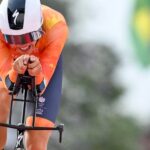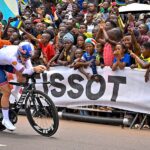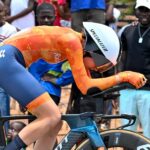Editor’s note: This story appears in David Houghton’s new book, Thirty Three Cyclists, which spotlights “thirty-three of the most unique people to ever ride a bicycle, from the world-famous to the utterly obscure.” Over the past three decades, Houghton has published five books, and his writing has appeared in numerous publications including Bicycling, Singletrack, Outside and Lonely Planet. An avid long-distance cyclist, he has participated in the Tour du Canada, Tour d’Afrique, Race Across America, and the Doomsday Ride.
In 1919, Roscoe “Fatty” Arbuckle was one of the highest-paid actors in Hollywood, after signing a $3 million multi-picture deal with Paramount. Arbuckle was friends with William Stephens, governor of California, and after a heated disagreement with Stephens, Arbuckle insisted that no man could ride a singlespeed bicycle across the country. To back up his claim, he offered $3,500 to the first person who did — as long as they arrived in New York City before November 1.
Navy recruits Tony Pizzo and C. J. Devine accepted the wager, convinced they could win the bet and split the prize. But the Navy would only let them take time off if the trip was used to spur recruitment. The paperwork for their sabbatical shuffled up through the ranks, and Pizzo and Devine’s ride was ultimately rubber-stamped by the Assistant Secretary of the Navy, Franklin Delano Roosevelt.
The Navy gave Pizzo and Devine strict demands for their journey. They had to wear their uniforms for the duration of the ride. The uniforms had to be kept neat and clean at all times, and their appearance would be verified by state governors along the route. They would ride forty-pound singlespeed bicycles, fitted with trunks for their gear — which didn’t amount to much.

Pizzo and Devine, both tall and fit, reported for their cross-country duty on May 19 at Venice, California. But Arbuckle, intent on making their ride even more challenging, raised the stakes. The two men would be attached to their bicycles by a three-and-a-half-foot chain and handcuffs. They would have to perform every daily routine chained to their bicycles: not only riding but eating, sleeping, and answering the call of nature.
After Arbuckle himself checked that the two cyclists were securely attached to their bikes, the duo set off. They made their way across California, and through the Mojave Desert towards Flagstaff, where they were shot at by border patrol agents. They were arrested and detained, then released only after their credentials had been verified.
Pizzo and Devine were never more than two feet away from their bicycles. “One can hardly realize the trouble that these two riders were put to,” the League of American Wheelmen reported, “for they had to eat, drink, wash and take care of themselves generally while handcuffed to their wheels.”
“It ain’t so bad as it sounds,” Pizzo told reporters two weeks into their journey. “When I ride into town everybody turns out to look me over. At first they take me for a prisoner. I am, in a way. But my bicycle is my only jailer. We get to be chums because where it goes I go.”
On a good day, the two recruits could cover a hundred miles. But most days, their progress amounted to less than thirty. Riding over unpaved roads, through loose sand and mud, they crashed often when their front wheels stopped unexpectedly. They were hounded by bad weather and persistent mechanical problems.
Devine’s ride seemed doomed from the start. Outside Flagstaff, he fell and broke his collarbone. He was taken to a local hospital for treatment, still chained to his bicycle, then later rejoined Pizzo. At the Grand Canyon, Devine nearly fell off a cliff when his bicycle rolled toward the edge.
While pedaling through Kansas, Devine was hit by a car, suffering a broken arm and shoulder. Unable to continue the trip, Devine urged Pizzo to ride the rest of the way to New York City on his own to claim the prize. Pizzo was eager to take up the challenge.
After five months in handcuffs and chains, Pizzo rolled up in front of the Hotel McAlpin in New York on October 30, two days before the deadline set by Arbuckle. In 165 days, he had covered 3,000 miles on a hard leather saddle, pedaling in soft-soled leather shoes. Without any fanfare, Pizzo checked into a room in the hotel, still handcuffed to his bicycle, and slept soundly with it beside him in his bed.
The following day, Mayor John Hylan cut Pizzo free of his bicycle. The Navy recruit had won the $3,500 bet, but he and his bicycle were no longer chums. When The New York Times asked him to describe his experience, Pizzo said plainly, “I wouldn’t make a trip like that again for a million dollars.”
But he did, and for much less.
The Humboldt Park Cycling Club, based in Chicago, heard about Pizzo’s accomplishment and put up a $5,000 wager that he wouldn’t repeat his ride from east to west. This was a dare that Pizzo couldn’t resist.
On April 24, 1920, six months after arriving in New York, Pizzo saddled up on his bike and began the ride back to Los Angeles, intent on proving the Humboldt Park Cycling Club wrong. This time, he rode with advertising support from Crown bicycles, Fisk tires and Morrow brakes. As he set off, The New York Tribune characterized the ride as “a foolish but daring endurance stunt.”
Once again Pizzo was handcuffed and chained to his handlebars, and once again he was accompanied by his fellow Navy recruit C. J. Devine. Devine had recovered from the injuries he’d sustained in Kansas, and agreed to act as manager and publicist, selling souvenir postcards, booking appearances with mayors and governors, and making presentations to encourage Navy recruitment along the route.
But, not surprisingly, Devine had no desire to ride, handcuffed to a bicycle, from New York to Los Angeles. He drove comfortably in a car behind his friend Tony Pizzo.
The post Three and a Half Feet of Chain appeared first on Adventure Cycling Association.






